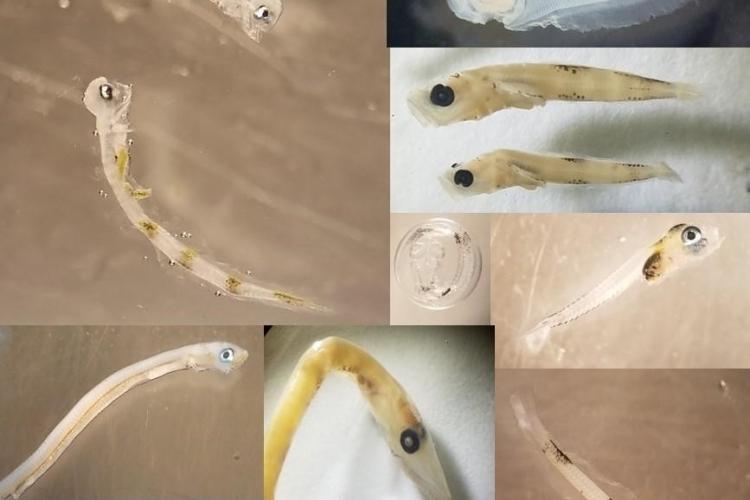Ichthyoplankton are the early stages of fish (eggs and larvae) that are not able to actively swim against currents. Ichthyoplankton are fascinating because they look very different from adults due to the challenges of being so small and adrift in the ocean. Like the young of other animals, larval fish have different requirements to survive and grow compared to adult fish, which makes ichthyoplankton an important component of fisheries management.
We capture ichthyoplankton from all of the marine systems surrounding Alaska (i.e., Gulf of Alaska, southeastern Bering Sea, Chukchi Sea, and Beaufort Sea) mainly with a bongo net, which received its name because it closely resembles a bongo drum, that we fish from near the bottom to the surface. Sometimes, we focus on ichthyoplankton that live near the surface. To capture these fish, we use a second gear called a neuston that just skims the surface.

Sampling gear used to collect larval fish.The bongo (left) collects larval fish throughout the water column whereas the neuston (right) collects larval fish concentrated near the sea surface.
In the Ichthyoplankton Team, we are interested in pursuing applied taxonomic and ecological research to address important data gaps related to basic life history information that can be applied by fisheries scientists in ecosystem approaches to management. Currently, approximately 50% of larval fish species have been described in the marine waters surrounding Alaska but there are still many questions yet to be answered, including:
- What species are found in the Arctic?
- What characters can we use to identify fish eggs and larvae to species?
- What ecosystem factors (prey, predators, temperature, salinity, etc.) influence the distribution, abundance, and survival of fish eggs and larvae?
- How might these distributions be influenced by climatic anomalies?
- What do the fish larvae eat and why?
As a first step in answering these questions, all fish eggs and larvae that are collected during our surveys in the large marine ecosystems around Alaska must be identified as precisely as possible. One innovative tool that was developed in our group was the Northeast Pacific Ichthyoplankton Information System (IIS), which is a dynamic online regional guide to the fish eggs and larvae of our region that is updated regularly as our knowledge about the species of the regions improves. Once samples are identified, and the data properly stored, the specimens are transferred to the University of Washington Fish Collection for permanent storage.
Our research is holistic in that we collaborate with NOAA Research’s Pacific Marine Environmental Laboratory to form EcoFOCI (Ecosystems and Fisheries Coordinated Investigations), which integrates research from different disciplines to understand the myriad of biological and physical factors that influence the survival, distribution, and abundance of fish eggs and larvae.
Contact
- Julie Keister, Recruitment Processes Program, EcoFOCI Program Manager



